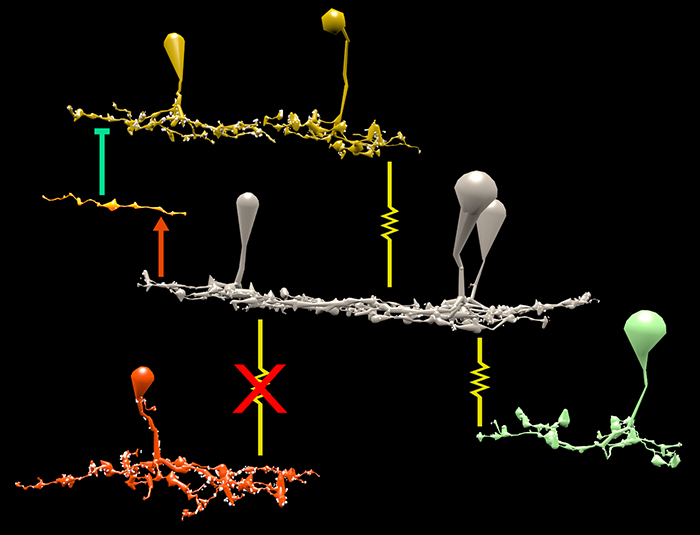This abstract was presented today at the 2014 Association for Research in Vision and Opthalmology (ARVO) meetings in Orlando, Florida by J Scott Lauritzen, Noah T. Nelson, Crystal L. Sigulinsky, Nathan Sherbotie, John Hoang, Rebecca L. Pfeiffer, James R. Anderson, Carl B. Watt, myself and Robert E. Marc.
Purpose: Despite large-scale efforts aimed at mapping the mammalian nervous system, the entire synaptic cohort of a single mammalian neuron of any class has never been mapped. To this end we reconstructed all chemical and electrical synaptic partners of a single ON cone bipolar cell in the inner plexiform layer (IPL) of the rabbit retina. We then searched all members of the same cell class for repeating network motifs and explored postsynaptic cell sampling topologies from this bipolar cell.
Methods: Cells in retinal connectome 1 (RC1) were annotated with Viking viewer, and explored via graph visualization of connectivity and 3D rendering (Anderson et al., 2011 J Microscopy). Small molecule signals embedded in RC1, e.g. GABA, glycine, and L-glutamate, combined with morphological reconstruction and connectivity analysis allow robust cell classification. The default resolution of RC1 is 2.18nm/pixel, however goniometric recapture at 0.273 nm/pixel was performed as needed for synapse and gap junction verification. We used the MacNeil et al. (2004 J Comp Neurol) rabbit BC classification scheme.
Results: CBb5w 593 is one of 20 bipolar cells (BC) of this class in RC1, the axonal arbors of which perfectly tile with gap junctions between nearest neighbors at their distal axonal tips. CBb5w 593 contains 194 ribbons, 274 postsynaptic densities (PSD), 20 gap junctions, 66 conventional synapses, and 126 adherins junctions, for a total of 554 synaptic connections and 126 mechanical connections. CBb5w 593 forms 12 gap junctions with at least 2 AII ACs, 7 with 5 CBb5ws, and 1 with itself. Twenty ganglion cells (GC) sample the glutamatergic output via 32 PSDs. CBb5w 593 drives 262 amacrine cell (AC) processes via 300 PSDs to ribbon synapses, and is postsynaptic to 228 AC processes via 258 conventional inhibitory synapses. Thirty-three percent of the AC processes form reciprocal connections with CBb5w 593. We approximate that CBb5w 593 is synaptically connected to 50 distinct ACs. CBb5w 593 drives 4 instances of within-class feedback inhibition, 13 instances of cross-class feedback inhibition to 5 distinct bipolar cell classes, 1 instance of within-class feedforward inhibition to an ON GC, and 5 instances of feedforward inhibition to as yet unidentified GC processes. CBb5w 593 receives 4 instances of within-class feedback inhibition, 9 instances of cross-class feedback inhibition from 4 distinct bipolar classes, and 1 instance of OFF ON crossover inhibition via an axonal PSD in the OFF IPL. The reported network motif numbers are likely much lower than actual instances, since these are based on partial reconstructions. We searched for repeating network motifs across all 20 CBb5w cells in RC1. Thus far, 16/20 (80%) CBb5w cells form in-class inhibitory motifs, and 15/20 (75%) form cross-class inhibitory motifs. All AC and GCs discovered to contact multiple branches of CBb5w 593 form synapses on every branch.
Conclusions: An individual bipolar cell is inherently multi-kinetic, receiving inhibition driven by bipolar cells in all IPL laminae, sharing these signals via gap junctions with bipolar cells of the same class, and driving inhibition of bipolar cells in all laminae. This constitutes a substrate for multi-channel coordination throughout the IPL, and predicts multi-kinetic bipolar responses. The results establish a normative framework against which members of the same and different classes may be compared, and foster interpretation of bipolar cell physiological behavior under different stimulus regimes.
Support: NIH EY02576 (RM), NIH EY015128 (RM), NSF 0941717 (RM), NIH EY014800 Vision Core (RM), RPB award to Moran Eye Center, RPB Career Development Award (BWJ), Thome Foundation grant for AMD Research (BWJ).
